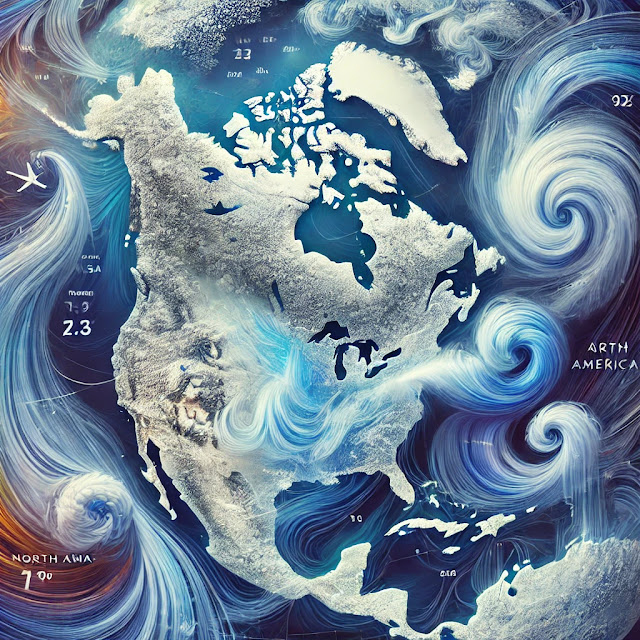Extreme Cold Warning in the United States: The Science Behind the Deep Freeze

This blog focuses on the articles based on science and technology. By reading this articles you would definitely develop interest in science. This articles would be only for educational purposes and would help you in knowing new tech things also with your studies , if you are science student.

Space weather might not dominate headlines like terrestrial storms, but its impact on modern life is profound. From disrupting GPS systems to endangering astronauts, solar storms—a phenomenon resulting from intense bursts of energy from the sun—pose significant challenges and opportunities. As technology becomes increasingly reliant on satellites and space infrastructure, understanding and preparing for space weather is more critical than ever.
What is Space Weather?
Space weather refers to conditions on the sun and its atmosphere that can affect Earth’s space environment. The primary culprits behind space weather events are:
Solar Flares: Sudden bursts of radiation from the sun’s surface that can cause communication blackouts.
Coronal Mass Ejections (CMEs): Massive ejections of plasma and magnetic fields from the sun’s corona, potentially disrupting power grids.
Solar Wind: Streams of charged particles emitted by the sun, influencing Earth’s magnetosphere and auroras.
The Science Behind Solar Storms
Solar storms originate in the sun’s outer atmosphere, where magnetic fields twist and tangle. When these magnetic fields snap, they release enormous amounts of energy. Traveling at speeds of up to 3 million miles per hour, the effects of these storms can reach Earth within a day or two, causing geomagnetic disturbances.
Impacts of Space Weather
Communication Disruptions
High-frequency radio communications used by airlines and the military can be interrupted.
GPS systems may become unreliable, affecting navigation for planes, ships, and autonomous vehicles.
Power Grid Failures
Geomagnetic storms can induce electric currents in power lines, overloading transformers and causing widespread blackouts.
The 1989 Quebec blackout, caused by a solar storm, left millions without power for hours.
Space Exploration Risks
Astronauts are at higher risk of radiation exposure during intense solar events.
Satellites can be damaged or knocked out of orbit, disrupting essential services.
Effects on Aviation
Increased radiation levels at high altitudes can pose health risks to passengers and crew.
Polar flight routes may need rerouting, increasing fuel costs and travel time.
Future Technologies to Mitigate Space Weather Risks
Early Warning Systems
NASA and other agencies monitor the sun with advanced satellites like the Solar Dynamics Observatory (SDO).
Real-time data helps predict solar storms and mitigate their impacts.
Hardened Infrastructure
Power grids and satellites are being designed to withstand geomagnetic disturbances.
Materials resistant to radiation are being developed for spacecraft.
Artificial Intelligence in Space Weather Prediction
AI algorithms analyze vast amounts of solar data to forecast storm intensity and timing.
Machine learning models are revolutionizing how scientists interpret solar patterns.
How Space Weather Could Shape Future Technologies
Space-Based Solar Power
Harnessing solar energy from space to power Earth could become a reality, but requires resilience to solar storms.
Enhanced Satellite Networks
As mega-constellations like Starlink grow, they’ll need better shielding from radiation and geomagnetic disruptions.
Radiation-Resistant Electronics
Future electronics, from smartphones to medical devices, may incorporate designs to resist space weather effects.
The Role of International Collaboration
Addressing space weather challenges requires global cooperation. Organizations like the International Space Weather Initiative (ISWI) unite scientists and policymakers to develop strategies and share data. Collaborative efforts are key to safeguarding humanity’s technological future.
Conclusion
Space weather may seem distant, but its effects are closer to home than we realize. As we step into an era dominated by space-based technologies, understanding and preparing for solar storms is not just a scientific necessity but a technological imperative. By investing in research, innovative technologies, and global cooperation, we can turn the challenges of space weather into opportunities for progress.
SEO Keywords
Space weather impacts
Solar storm effects
Geomagnetic storms
Solar flares and technology
Future of space weather prediction
Comments
Post a Comment